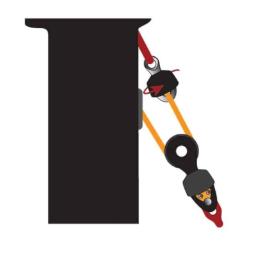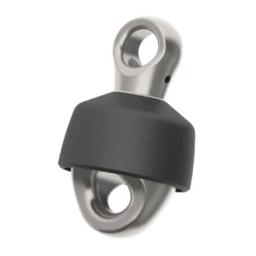Sailing is a harmonious balance of skill, science, and equipment. Among the countless technical details that can impact performance and efficiency, the use of an anti-twist swivel stands out as a key solution to managing halyard twist, particularly in 2:1 halyard setups. This seemingly small problem can have a significant impact on both the performance of the rig and the longevity of the gear. Understanding why twist occurs and how to mitigate it is essential for every sailor striving for optimal performance.
What is Halyard Twist?
Halyard twist refers to the tangling or spiraling of the halyard as it runs through the sheaves, around the masthead, or in its interaction with the sail. In a 2:1 halyard configuration, where the halyard is dead-ended at the masthead and the halyard runs down to a block on the top of the sail and back through a masthead halyard sheave, the potential for twist increases significantly due to the doubling of the line’s travel and the potential for friction between the rope and block.

The twist can cause the halyard to jam, reduce the efficiency of sail hoisting or lowering, and increase wear on both the halyard and associated blocks. In severe cases, it can even damage the sheaves or masthead fittings. Addressing halyard twist is thus both a performance and maintenance concern.
How Does Twist Occur?
Halyard twist is often the result of several contributing factors:
1. Line Construction: Braided halyards or lines with uneven core or sheath tensions are more prone to twisting under load. When tension is applied to these lines, the fibers may naturally spiral.
2. Block Orientation: The orientation of the block at the masthead or on the sail can inadvertently encourage twisting, especially if the block’s axis of rotation does not align perfectly with the halyard’s path. Additionally, the orientation of deck blocks is crucial. The route from the halyard winch to the mast base should be as straight as possible, as a diverted line is more likely to twist under load.
3. Masthead Sheave Design: Halyards must pass smoothly over the sheaves at the masthead. Poorly aligned or worn sheaves can create uneven friction, causing the halyard to spiral.
4. Handling and Rigging Practices: Improper flaking or coiling of the halyard can introduce twists even before the line is loaded. Additionally, handling the halyard roughly during hoisting or furling can exacerbate any existing twists. A common practice that contributes to twist is throwing turns off a winch during a halyard drop. This action can introduce twists into the system, which are then pushed up the halyard during the next hoist, compounding the problem.
5. Wind and Motion Dynamics: As the boat moves and the sail flutters or luffs, dynamic forces can cause the halyard to rotate within the block, slowly accumulating twists.
The Role of Anti-Twist Swivel in Preventing Halyard Twist
One of the most effective tools for managing halyard twist is the anti-twist swivel. Anti-twist swivel is designed to allow free rotation of the halyard, preventing twists from being transferred through the system. Installing an anti-twist swivel just below the halyard dead-end point can significantly reduce twisting, ensuring smoother hoisting and lowering operations.

Anti-twist swivel is especially beneficial in high-load applications where even small inefficiencies can lead to performance issues. By allowing the halyard to rotate freely, these swivels eliminate the accumulation of twists over time, reducing wear and tear on both the line and the associated hardware.
Additional Strategies to Prevent, Minimize, or Manage Halyard Twist
While anti-twist swivel is a powerful solution, they work best when combined with other strategies:
1. Choose Low-Twist Lines: Modern halyards are often made from high-tech materials such as Dyneema or Spectra, which resist twisting better than traditional polyester ropes. When selecting a halyard, prioritize lines with tightly braided covers and balanced cores to reduce the risk of spiraling.
2. Inspect Blocks and Sheaves: Regularly inspect all blocks and masthead sheaves for wear, misalignment, or damage. Ensure that blocks can swivel freely and are correctly aligned with the direction of the halyard’s load.
3. Manage Halyard Storage: When not in use, halyards should be flaked or coiled carefully to avoid introducing unnecessary twists. Avoid twisting motions when coiling lines, and consider using figure-eight patterns instead of circular coils.
4. Hoist and Lower Smoothly: Rapid or jerky movements during hoisting or lowering can exacerbate twists. Take your time to feed the halyard smoothly, maintaining even tension throughout the process. Avoid throwing turns off the halyard winch, as this practice introduces twist into the system, which can accumulate and cause issues during the next hoist.
5. Reverse or Swap Halyards: Over time, halyards may develop memory or twist tendencies due to consistent loading patterns. Reversing the halyard’s direction or swapping it with a different halyard can help mitigate these tendencies.
6. Regularly Untwist the Halyard: Periodically detaching the halyard and manually removing twists by running it out fully can help manage buildup. Some sailors find it helpful to use the motion of the boat—such as running downwind—to help untwist the halyard more effectively.
Conclusion on Anti-twist swivel
Halyard twist in 2:1 setups is an often-overlooked issue that can lead to performance inefficiencies and increased gear wear. Installing an anti-twist swivel is one of the simplest and most effective ways to address this problem. Combined with good handling practices, regular maintenance, and proper line selection, an anti-twist swivel can significantly enhance your sailing experience.
Explore our range of swivel connectors designed to reduce halyard twist and improve rigging performance: Swivel Connectors Category. Prioritize the right gear to keep your sailboat operating at its best:


The Role of Anti-Twist Swivel in Managing Halyard Twist in 2:1 Halyard Setups